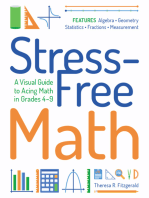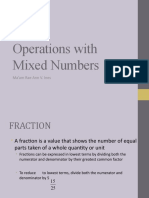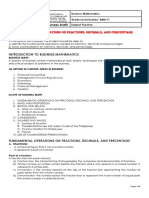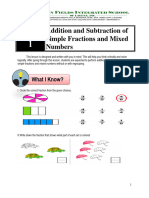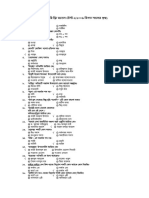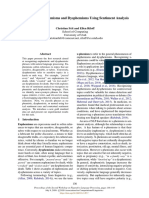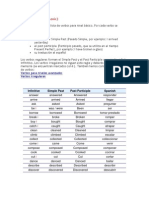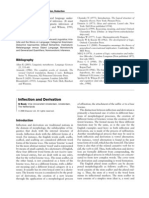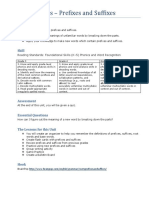Adding & Subtracting Fractions _ Rules & Examples - Lesson 8
Uploaded by
hiteachermimiAdding & Subtracting Fractions _ Rules & Examples - Lesson 8
Uploaded by
hiteachermimiAdding & Subtracting Fractions | Rules & Examples
Contributors: Brigette Banaszak, Jared Taylor
to
Learn You are viewing
define thisand
addition lesson on a parent
subtraction of account. Please
fractions. log inhow
Discover to your student
to add and account
subtracttofractions
track your progress.
with like
denominators and unlike denominators. See examples.
Table of Contents
Adding and Subtracting Fractions
Adding Fractions with Like Denominators
Subtracting Fractions with Like Denominators
Lesson Summary
Adding and Subtracting Fractions
A fraction shows equal parts of a whole. The bottom number in a fraction, the denominator,
shows how many equal parts the whole is divided into. The top number, the numerator, shows
how many of the parts are being considered. In the diagram, the circle is divided into 4 parts, and 1
part is colored.
A fraction shows equal parts of a whole
Adding and subtracting fractions involves putting together fractions or taking away from fractions.
The addition and subtraction of fractions is explained in this lesson.
A proper fraction is a fraction in which the numerator is smaller than the denominator, like 23 . An
improper fraction is a fraction in which the numerator is larger than the denominator, like 53 . A
mixed number includes both a whole number and a proper fraction, like 3 12 . Mixed numbers can
also be added or put together, and subtracted or taken away.
How can someone convert from mixed numbers to improper fractions and vice versa?
To convert from a mixed number to an improper fraction, multiply the denominator of the fraction
by the whole number. Then, add the numerator. This number becomes the numerator of the
improper fraction.
How to convert a mixed number to an improper fraction
To convert from an improper fraction to a mixed number, divide the numerator by the
denominator to find the whole number part. The remainder becomes the numerator of the fraction
part.
How to convert an improper fraction to a mixed number
Adding Fractions with Like Denominators
Only like fractions can be added. What is a like fraction? A like fraction is a fraction which is
divided into the same number of equal parts as another fraction. For example, in the fraction 5 ,
2
the whole is divided into 5 equal parts. The fraction 15 also represents a whole divided into 5 equal
parts. These are like fractions.
What are the rules for adding fractions with like denominators? Here are the steps to follow when
adding fractions with like denominators:
Change mixed numbers to improper fractions if needed.
Add the numerators.
Write the new numerator over the denominator.
Put the sum in its lowest terms. This might mean reducing the fraction or changing it to a mixed
number.
Here are some examples of adding fractions with like denominators.
Example 1
What is the sum of 38 + 8?
1
There are no mixed numbers in this problem, so the first step is to add the numerators:
3 + 1 = 4
Then, write the new numerator over the denominator: 8
4
Finally, put the sum in its lowest terms. This means to write the fraction in the simplest way
possible by dividing the numerator and denominator by a common factor.
4 1
8 = 2
So, 38 + 1
8
= 1
2
Example 2
What is the sum of 3 10 10 ?
1 3
+
First, write the mixed number as an improper fraction: 3 10
1
= 31
10
Then, add the numerators: 31 + 3 = 34
Next, write the new numerator over the denominator: 10
34
Finally, put the sum in its lowest terms. In this example, the improper fraction is first changed to a
mixed number. Then, the fractional part of the mixed number is written in the simplest way
possible.
34 4
10
= 3 10 = 3 25
So, 3 10
1
+ 3
10
= 3 25
Adding Fractions with Unlike Denominators
Fractions with unlike denominators are fractions in which the whole is split into different
numbers of parts, like 35 and 78 . Unlike fractions must be rewritten as like fractions before they can
be added. This means finding a common denominator, or rewriting both fractions using the same
denominator.
Here are the steps to follow when adding fractions with unlike denominators:
Change mixed numbers to improper fractions if needed.
Rewrite fractions using a common denominator.
Add the numerators.
Write the new numerator over the denominator.
Put the sum in its lowest terms. This might mean reducing the fraction or changing it to a mixed
number.
Here are some examples of how to add fractions with unlike denominators.
Example 1
What is the sum of 38 + 4?
3
There are no mixed numbers in this problem, so the first step is to find a common denominator.
The common denominator is a common multiple of the denominators. A common multiple of 8
and 4 is 8, so 8 can be the common denominator. Now, both fractions must be rewritten with a
denominator of 8. This can be done by multiplying both the numerator and the denominator of a
fraction by the same number.
3 2 6
4 × 2 = 8
Now the problem is addition with like denominators: 38 + 6
8
Continue by adding the numerators, writing the new numerator over the denominator, and putting
the sum in its lowest terms.
3 6 9 9
8
+ 8
= 8 8
= 1 18
So, 34 + 6
8 = 1 18
Example 2
Kimi's puppy weighs 2 34 pounds, and then he gains 23 pounds. How much does the puppy weigh
now?
Finding the puppy's weight means finding the sum of
2 34 + 2
3
First, write the mixed number as an improper fraction:
2 34 = 11
4
Now, the problem is 11
4 + 2
3
The next step is to find a common denominator. The common denominator is a common multiple
of the denominators. A common multiple of 4 and 3 is 12, so 12 can be the common denominator.
Now, both fractions must be rewritten with a denominator of 12. This can be done by multiplying
both the numerator and the denominator of a fraction by the same number.
11 3 33 2 4 8
4
× 3
= 12 3
× 4
= 12
Now the problem is addition with like denominators: 33
12 + 8
12
Continue by adding the numerators, writing the new numerator over the denominator, and putting
the sum in its lowest terms.
33 8 41 41 5
12
+ 12
= 12 12
= 3 12
So, 2 34 + 2
3
5
= 3 12
Subtracting Fractions with Like Denominators
Only like fractions can be subtracted. What are the rules for subtracting fractions with like
denominators? Here are the steps to follow when subtracting fractions with like denominators:
Change mixed numbers to improper fractions if needed.
Subtract the numerators.
Write the new numerator over the denominator.
Put the sum in its lowest terms. This might mean reducing the fraction or changing it to a mixed
number.
Here are some examples of how to subtract fractions with like denominators.
Example 1
What is the difference of 56 − 1
6
?
There are no mixed numbers in this problem, so the first step is to subtract the numerators:
5 − 1 = 4
Video Transcript
Adding Like Fractions and Mixed Numbers
To add fractions you must have a common denominator. When looking at your fraction, you need
to make sure that the fractions you are adding have the same denominator. Once your
denominators are the same, you can simply add the numerators. You will keep the same
denominator for your answer.
If your fraction contains a whole number, it would be called a mixed number. When adding mixed
numbers, first add your numerators and then your whole numbers. Again, the denominator in your
answer will stay the same.
Adding Like Fractions Example
Todd and James work on a farm collecting eggs from the hens. They both work to fill cartons that
can contain up to 12 eggs each. Todd and James have a basket full of eggs that they must now put
into the cartons. They both start stacking each carton with 12 eggs.
As Todd grabs the last egg, he sees that he has collected 4 full cartons and 5 eggs in the next
carton. His fraction would represent 4 5/12.
James starts counting his eggs; he collected 6 full cartons and 2 eggs in the next carton. His fraction
would represent 6 2/12.
The two boys now want to know how many eggs they collected together. They will need to add 4
5/12 + 6 2/12.
The two boys can see that both of their fractions have a denominator of 12. Since they have a
common denominator, they can just add their numerators and then their whole numbers. The
boys know that they will keep the same denominator.
So 5 + 2 is 7, and the whole numbers, 4 + 6, are 10. This makes their combined amount of eggs 10
and 7/12. The boys know that they collected 10 full cartons and 7 out of 12 eggs in the next carton.
Subtracting Like Fractions and Mixed Numbers
Same as adding fractions, to subtract fractions you must have a common denominator. When
looking at your fraction, you need to make sure that the fractions you are subtracting have the
same denominator. Once your denominators are the same, you can simply subtract the
numerators. When subtracting mixed numbers, first subtract your numerators and then subtract
your whole numbers.
Subtracting Fractions Example
Let's look at an example of subtracting mixed numbers. Donald works at the Apple store and things
are really busy with the release of the new iPhones. Donald knows that the iPhones come in cases
that hold 6 phones per case. He can see that they have 10 full cases and only 4 phones in another
case. His fraction would represent 10 4/6 cases of iPhones in stock.
Throughout the day, the store was full of customers buying phones. At the end of the day, Donald
learns that they sold 7 2/6 cases of iPhones. He now needs to know how many cases he has left to
sell. Donald must subtract 10 4/6 - 7 2/6 to see how many cases the store has remaining.
To begin, Donald can see that he has a common denominator of 6 in both fractions. He can now
subtract his numerators and then his whole numbers. 4 - 2 is 2 and the whole numbers, 10 - 7, are
3. Donald can see that his fraction is 3 2/6.
He knows that he needs to report the number in simplest form. So 2 and 6 will both divide by 2,
making his fraction 3 1/3. Donald now knows that the store only has 3 1/3 cases of iPhones
remaining.
Lesson Summary
So let's look back at this skill of adding and subtracting like fractions and mixed numbers. To add
and subtract fractions you must have a common denominator. When looking at your fraction, you
need to make sure that the fractions you are adding or subtracting have the same denominator.
Once your denominators are the same, you can simply add or subtract the numerators. When
you're adding and subtracting mixed numbers, first add or subtract your numerators, and then
you'll add or subtract your whole numbers.
Frequently Asked Questions
What are the steps for adding and subtracting fractions?
When adding or subtracting fractions, follow these steps:
1. Rewrite any mixed numbers as improper fractions.
2. If needed, rewrite fractions with a common denominator.
3. Add or subtract the numerators and write the answer over the denominator.
4. Change to a mixed number and/or write fraction in lowest terms.
How do you add and subtract fractions with different denominators?
Before adding or subtracting fractions with different denominators, the fractions must be
written using a common denominator. The common denominator will be a multiple of the two
denominators. Then, rewrite the fractions using the common denominator, and add or
subtract.
You might also like
- Adding and Subtracting Fractions Powerpoint100% (3)Adding and Subtracting Fractions Powerpoint18 pages
- Stress-Free Math: A Visual Guide to Acing Math in Grades 4-9From EverandStress-Free Math: A Visual Guide to Acing Math in Grades 4-9No ratings yet
- GRE - Quantitative Reasoning: QuickStudy Laminated Reference GuideFrom EverandGRE - Quantitative Reasoning: QuickStudy Laminated Reference GuideNo ratings yet
- Addition and Subtaction of Similar FractionsNo ratings yetAddition and Subtaction of Similar Fractions10 pages
- Presented By: Rizza M. Pacheo, Sr. Kristina Tay, Sr. War War, LwinNo ratings yetPresented By: Rizza M. Pacheo, Sr. Kristina Tay, Sr. War War, Lwin57 pages
- Adding and Subtracting Fractions PowerPointNo ratings yetAdding and Subtracting Fractions PowerPoint20 pages
- Performing Fundamental Operations With Fractions and DecimalsNo ratings yetPerforming Fundamental Operations With Fractions and Decimals35 pages
- Adding and Subtracting Fractions Powerpoint100% (1)Adding and Subtracting Fractions Powerpoint23 pages
- LESSON 2 - Operations With Mixed NumbersNo ratings yetLESSON 2 - Operations With Mixed Numbers35 pages
- Add and Subtract Fractions Notes Like and UnlikeNo ratings yetAdd and Subtract Fractions Notes Like and Unlike4 pages
- 1Q M6 Module 1 Addition and Subtraction of Fractions FinalNo ratings yet1Q M6 Module 1 Addition and Subtraction of Fractions Final22 pages
- Adding and Subtracting Fractions PowerpointNo ratings yetAdding and Subtracting Fractions Powerpoint17 pages
- MODULE 1 - Business Math: Fundamental Operations On Fractions, Decimals, and Percentage100% (1)MODULE 1 - Business Math: Fundamental Operations On Fractions, Decimals, and Percentage6 pages
- Fractions: Adding and Subtracting: 1. 2 2. Fractions With Different Denominators 3 3. Mixed Fractions 5No ratings yetFractions: Adding and Subtracting: 1. 2 2. Fractions With Different Denominators 3 3. Mixed Fractions 56 pages
- (5) LP Adding and Subtracting Similar FractionsNo ratings yet(5) LP Adding and Subtracting Similar Fractions10 pages
- 5.2-5.4 Materials: Least Common Denominator (LCD) : The Least Common Multiple of The Different DenominatorsNo ratings yet5.2-5.4 Materials: Least Common Denominator (LCD) : The Least Common Multiple of The Different Denominators4 pages
- Adding Fractions With The Same DenominatorNo ratings yetAdding Fractions With The Same Denominator35 pages
- Fraction: A Represents A Part of A WholeNo ratings yetFraction: A Represents A Part of A Whole28 pages
- Adding and Subtracting Fractions Worksheets0% (1)Adding and Subtracting Fractions Worksheets13 pages
- Fundamental Operations On: Fractions, Decimals, and Percentage. Learning OutcomesNo ratings yetFundamental Operations On: Fractions, Decimals, and Percentage. Learning Outcomes67 pages
- Adding and Subtracting Fractions WorksheetsNo ratings yetAdding and Subtracting Fractions Worksheets14 pages
- Add and Subtracting Fractions With Unlike DenominatorsNo ratings yetAdd and Subtracting Fractions With Unlike Denominators40 pages
- GEd 104 Research Paper Content and FormatNo ratings yetGEd 104 Research Paper Content and Format3 pages
- Jobtestprep'S Numeracy Review: FractionsNo ratings yetJobtestprep'S Numeracy Review: Fractions9 pages
- Fractions-Add and Subtract W/mixed Numbers: Grade Level: 5No ratings yetFractions-Add and Subtract W/mixed Numbers: Grade Level: 511 pages
- Master Fracions Addition, Subtraction And Multiplication: Math Childern BookFrom EverandMaster Fracions Addition, Subtraction And Multiplication: Math Childern BookNo ratings yet
- Small to Largest Number Names_ Charts & Tables ― JustinTOOLs.comNo ratings yetSmall to Largest Number Names_ Charts & Tables ― JustinTOOLs.com3 pages
- What Does Threatened Mean - Google SearchNo ratings yetWhat Does Threatened Mean - Google Search1 page
- Fractions Convert Mixed To Improper AllNo ratings yetFractions Convert Mixed To Improper All20 pages
- Morphological Structure of A Word. Word-Formation in Modern English 1. Give The Definition of The Morpheme100% (1)Morphological Structure of A Word. Word-Formation in Modern English 1. Give The Definition of The Morpheme22 pages
- Recognizing Euphemisms and Dysphemisms Using Sentiment AnalysisNo ratings yetRecognizing Euphemisms and Dysphemisms Using Sentiment Analysis10 pages
- Collocations: Fast Foodthe Quick Train A Quick Meala Fast ShowerNo ratings yetCollocations: Fast Foodthe Quick Train A Quick Meala Fast Shower3 pages
- Proper Improper Mixed Number FractionsNo ratings yetProper Improper Mixed Number Fractions21 pages
- Skill Lessons - Prefixes and Suffixes PDFNo ratings yetSkill Lessons - Prefixes and Suffixes PDF12 pages






